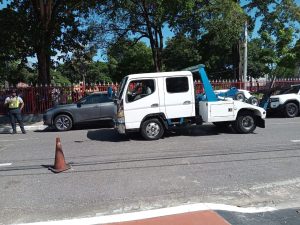By Sue-Ann Wayow
FOR failing to reduce driving speeds at emergency scenes motorists can face serious charges such as causing death by dangerous driving.
A Trinidad and Tobago Police Service (TTPS) press release issued the warning on Tuesday following the incident in which a WPC was hit by a truck while responding to a road traffic accident last Saturday.
WPC Erica Jacob, of the Traffic and High way Patrol Branch, Central Division, was responding to the accident around 3 pm along the northbound lane of the Uriah Butler Highway when she was seriously injured.
She remains warded at hospital in the Intensive Care Unit. The truck driver has been detained in the Northern Division assisting police with investigations.
The executive of the TTPS continues to pray for her and her family at this time, the TTPS stated.
According to the Motor Vehicles and Road Traffic Act, 2000, Section 71A stated that any person who causes the death of another person by driving a motor vehicle dangerously on a road, is liable on conviction on indictment to imprisonment for 15 years.
Also, a person convicted of an offence under this section shall be disqualified for a period of 15 years from the date of the conviction from holding or obtaining a driving permit, and on a second conviction for a like offence, shall be permanently disqualified from holding or obtaining a driving permit.
Acting Senior Superintendent of Police, Traffic and Highway Patrol Branch, Wayne Mystar, is urging motorists who commute on the nation’s highways to remain extremely vigilant upon seeing emergency vehicle lights and to fully cooperate with the directions of law enforcement and first responders.
Mystar said, “Motorists should firstly reduce their speed, give way to emergency vehicles and stay clear of the scene of an accident. Emergency vehicle warning lights are purposefully used to indicate the presence of first responders such as police, fire, emergency medical technicians and wrecking teams on the roadways and aid in ensuring their safety. As a best practice, drivers should give emergency responders at least 1.5 meters (five feet) of operating space and move out of the lanes where personnel are working.”

He explained, “Police officers responding to road traffic incidents must often deal with multiple situations ranging from assisting drivers, passengers or other road users who may have been injured in the incident, to securing the scene to mitigate the risk of secondary accidents from occurring. Drivers need to increase their level of alertness when approaching any situation where police or other emergency responders are present.”
TTPS Road Safety Project Coordinator, Sgt Brent Batson added that traffic officers were exposed to greater risk.
“Highway Patrol officers are at greater risk due to the high speed of 100 km/h on the roads they police where seconds are critical for a driver being able to react and control a motor vehicle to safely avoid hazards on the road.
“At an accident, there are multiple moving parts each with its own inherent risk and the officers there have to ensure that the roads are safe before any lanes can be reopened to traffic and this includes situational considerations such as dealing with injured persons who may need critical medical assistance, spillage of vehicle oils and dangerous debris on the road.”
![]()











